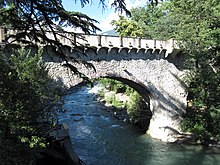This is an old revision of this page, as edited by JJMC89 bot III (talk | contribs) at 01:40, 25 August 2024 (Merging Category:Bridges completed in 1617 to Category:Transport infrastructure completed in 1617 and Category:Bridges completed in the 17th century per Misplaced Pages:Categories for discussion/Log/2024 August 11#Bridges by year 1400-1700). The present address (URL) is a permanent link to this revision, which may differ significantly from the current revision.
Revision as of 01:40, 25 August 2024 by JJMC89 bot III (talk | contribs) (Merging Category:Bridges completed in 1617 to Category:Transport infrastructure completed in 1617 and Category:Bridges completed in the 17th century per Misplaced Pages:Categories for discussion/Log/2024 August 11#Bridges by year 1400-1700)(diff) ← Previous revision | Latest revision (diff) | Newer revision → (diff)

The Steinerner Steg (Template:Lang-it) is a two-arched, stone-built footbridge across the Passer in Merano, South Tyrol, northern Italy. The oldest bridge in the town, it connects the historic centre and the Steinach district with the Obermais quarter.
In 1615 the wooden aqueduct which spanned the river here had fallen into disrepair and the town decided to demolish it and build a stone bridge in its place. The following year Andrä Tanner, an architect from Brixen, was contracted to build the replacement. Scarcely had the works been completed, however, when the new bridge was washed away in a flood. The current structure was completed in 1617. The bridge is in close proximity to the Passeirer Tor, one of the town gates of Merano.
Naming
“Steinerner Steg” is simply German name for “stone footbridge”, while “Ponte Romano” is the Italian equivalent of “Roman bridge”. Although the latter name has been taken to imply that the bridge might have ancient Roman origins, but in fact “Ponte Romano” was only introduced on December 2, 1927 by the fascist authorities as part of their Italianization of South Tyrol campaign.
Notes
- Attrazioni (in Italian) / Sehenswürdigkeiten (in German), website of the Municipality.
- ^ Januth, Günther (2008), Written responses given by the mayor of Meran to various questions from councillors (PDF) (in Italian), Stadtgemeinde Meran / Comune di Merano. See section 20.
Further reading
- Stampfer, Cölestin (1889), Geschichte von Meran, der alten Hauptstadt des Landes Tirol, Innsbruck, p. 118, ISBN 3-500-30390-0
{{citation}}: CS1 maint: location missing publisher (link)
External links
[REDACTED] Media related to Steinerner Steg at Wikimedia Commons
46°40′18″N 11°10′09″E / 46.67167°N 11.16917°E / 46.67167; 11.16917
Categories: